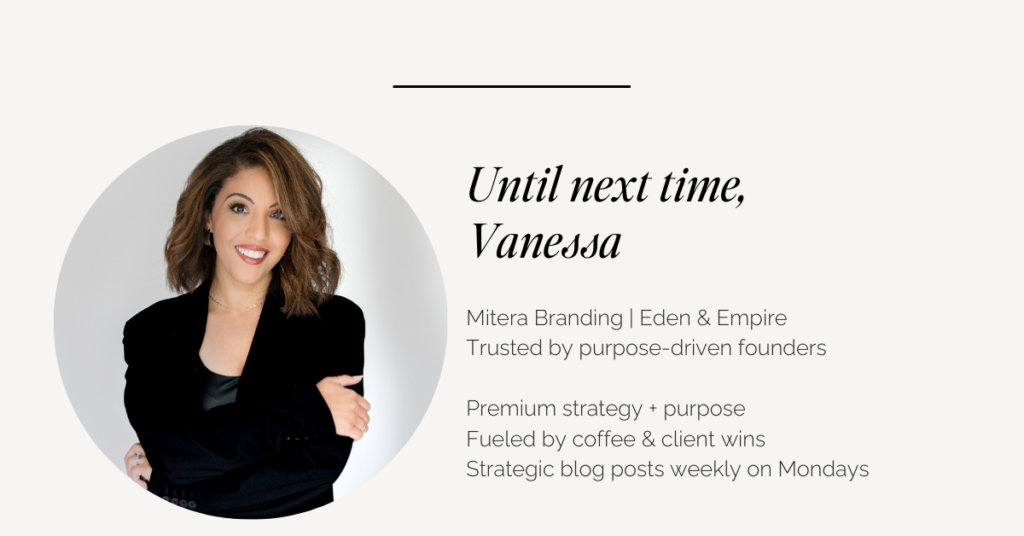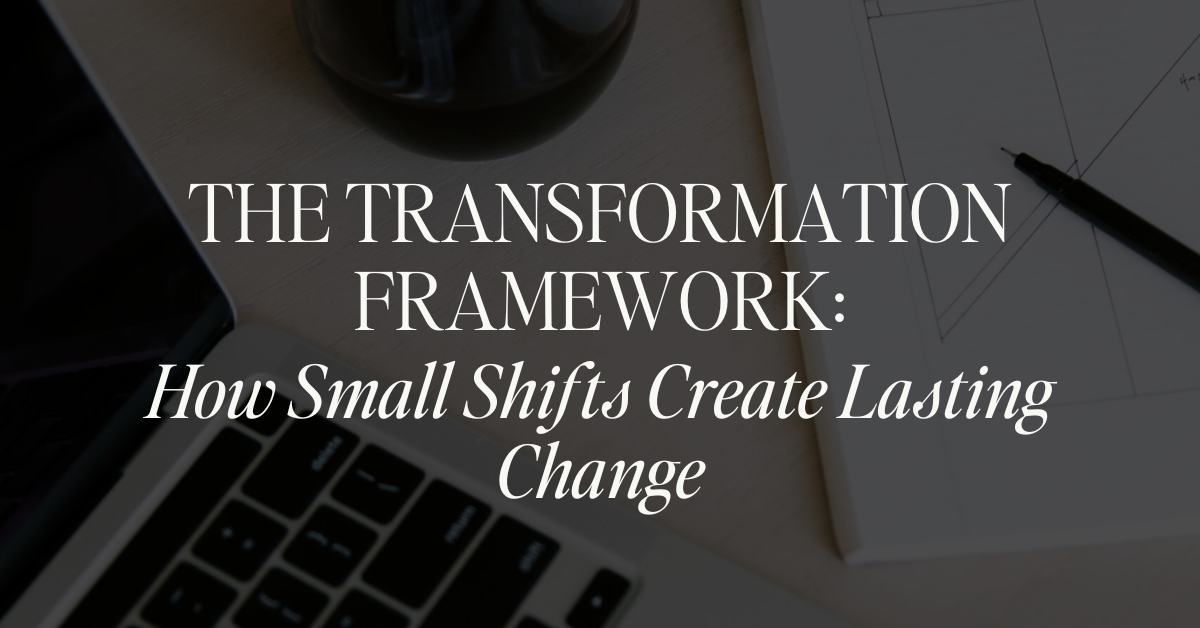Have you ever felt stuck in that frustrating cycle? You know you need to make changes in your life or business, so you throw yourself into a massive overhaul—new systems, new habits, new everything—only to find yourself back at square one a few weeks later, exhausted and discouraged.
If you’re nodding your head right now, you’re not alone. So many of us approach transformation with an “all or nothing” mindset that actually sets us up for failure from the start. We’ve been conditioned to believe that meaningful change requires dramatic action, when in reality, the opposite is often true.
Here’s a truth that transformed my own approach to growth: Lasting change rarely comes from massive overnight shifts. It emerges from small, consistent adjustments that compound over time into remarkable transformation.
“Do not despise these small beginnings, for the LORD rejoices to see the work begin.” This wisdom from Zechariah 4:10 reminds us that transformation often starts with humble, seemingly insignificant steps that lay the foundation for something much greater.
What if the breakthrough you’ve been seeking isn’t about radical reinvention but about identifying the smallest possible shifts that would create the most significant impact? What if sustainable transformation is less about willpower and more about wisdom in where you focus your energy?
Let’s explore five principles that form the Transformation Framework—a approach to creating lasting change through intentional, manageable shifts rather than overwhelming overhauls.
1. Embrace the Power of Micro-Shifts
“Whoever can be trusted with very little can also be trusted with much.” – Luke 16:10

One of the most profound insights about transformation is that our smallest actions often reveal and reinforce our deepest patterns. While we tend to focus on major changes, it’s usually the tiny, consistent shifts that create sustainable transformation.
Micro-shifts are small, manageable changes that:
- Require minimal willpower to implement
- Can be sustained even during challenging periods
- Gradually rewire your default patterns and responses
- Compound over time into significant transformation
- Create momentum that makes larger changes possible
Rather than attempting complete overhauls, micro-shift thinking asks: “What is the smallest change I could make that would create meaningful impact in this area?”
For example, instead of completely redesigning your morning routine, you might start with just five minutes of intentional planning before checking email. Instead of revamping your entire business model, you might adjust one client conversation to include a specific question that reveals deeper needs.
The power of micro-shifts lies not in their immediate impact but in how they gradually transform your patterns, perspectives, and possibilities.
Consider areas where you’re seeking change:
- What smallest shift in this area would create a noticeable ripple effect?
- Where have you been trying to make massive changes when a micro-shift might be more sustainable?
- What tiny adjustment to your daily patterns would align you more closely with your desired direction?
- What small shift in perspective would change how you approach this challenge?
2. Identify the Leverage Points of Transformation
“Give me a lever long enough and a fulcrum on which to place it, and I shall move the world.” – Archimedes
Not all changes create equal impact. Some shifts, though seemingly small, affect entire systems because they occur at critical leverage points—places where minimal input creates maximum output.
The principle of leverage teaches us to look for the highest-impact points for our transformation efforts rather than trying to change everything at once.
Leverage points in personal and business transformation might include:
- Core beliefs that influence countless decisions
- Key relationships that affect multiple areas of life
- Critical decision points in important processes
- Foundational habits that impact energy and capacity
- Essential skills that unlock multiple opportunities
For example, a micro-shift in how you begin client relationships might transform all subsequent interactions. A small adjustment in how you process emotional triggers could change dozens of conversations and decisions each day.
The key is identifying which small changes would create the most significant downstream effects.
To apply this principle:
- Where in your life or business do small decisions create large impacts?
- What patterns, if shifted slightly, would affect multiple areas positively?
- Which of your habits or practices serve as foundational building blocks for others?
- What relationships or connections, if strengthened, would create positive ripple effects?
- Where have you been applying significant effort with minimal results?

3. Create Systems That Support Small Shifts
“The plans of the diligent lead to profit as surely as haste leads to poverty.” – Proverbs 21:5
Sustainable transformation isn’t primarily about motivation or willpower—it’s about creating supportive environments and systems that make your desired shifts the path of least resistance rather than the path of greatest effort.
This principle recognizes that environment often trumps intention. Even the most committed person will struggle to maintain changes that constantly fight against their surroundings, schedules, and systems.
Transformation-supporting systems might include:
- Physical environments designed for your desired behaviors
- Digital spaces that minimize distraction and maximize focus
- Scheduling approaches that protect time for priority activities
- Accountability structures that provide support and feedback
- Routines that reduce decision fatigue around important shifts
For example, if a key micro-shift involves more strategic thinking time, you might create a system with a dedicated physical space, scheduled calendar blocks, prepared thinking prompts, and accountability check-ins.
To design systems that support your transformation:
- What environmental adjustments would make your desired shifts easier to maintain?
- How could you reduce friction for the changes you want to make?
- What triggers or cues could remind you of your intended micro-shifts?
- Who could provide the right accountability for your transformation journey?
- What current systems are working against your desired changes?
4. Practice Reflection That Reveals Hidden Patterns
“Search me, God, and know my heart; test me and know my anxious thoughts.” – Psalm 139:23
Sustainable transformation requires not just action but awareness. Without intentional reflection, we often miss the underlying patterns driving our current reality and limiting our growth.
This principle invites us to build regular reflection practices that reveal:
- Unconscious beliefs driving decision patterns
- Hidden resistance to desired changes
- Unrecognized progress that deserves celebration
- Unexpected impacts of the shifts you’re making
- Emerging opportunities for additional micro-adjustments
Effective reflection isn’t just passive thinking—it’s active inquiry guided by powerful questions that illuminate what would otherwise remain hidden.
Transformation-oriented reflection practices might include:
- Regular journaling with specific prompts about your shift areas
- Guided assessment of what’s working and what needs adjustment
- Intentional celebration of progress, however small
- Exploration of resistance when changes feel unusually difficult
- Identification of unexpected benefits from the shifts you’ve made
To strengthen your reflection practice:
- What regular rhythm of reflection would best support your transformation?
- Which questions consistently reveal helpful insights when you consider them?
- How might you more intentionally connect reflection to action?
- What hidden patterns might be influencing your growth journey?
- Where have you made progress that deserves acknowledgment?
5. Embrace the Compounding Effect of Consistency
“Let us not become weary in doing good, for at the proper time we will reap a harvest if we do not give up.” – Galatians 6:9
Perhaps no principle is more crucial to the Transformation Framework than understanding the remarkable power of consistency over time. Small shifts maintained consistently create compound effects that eventually lead to breakthrough moments that appear sudden but were actually building gradually all along.
This principle reminds us that transformation:
- Often follows a non-linear path with periods of invisible progress
- Requires faith during plateaus when results aren’t yet visible
- Eventually reaches tipping points where results suddenly accelerate
- Values consistent small steps over sporadic major efforts
- Compounds in impact over time in unexpected ways
The challenge is maintaining consistency with your micro-shifts during the “valley of disappointment”—the period where you’re putting in effort but not yet seeing significant results. This is precisely where most transformation efforts fail, just before they would have reached the breakthrough point.
To leverage the compound effect of consistency:
- How might you maintain motivation during periods when results aren’t yet visible?
- What would help you trust the process when progress seems slow?
- How could you track the less obvious impacts of your consistent micro-shifts?
- What support structures would help you maintain consistency through challenges?
- How might you reframe your expectations around the timeline of transformation?
Implementing Your Transformation Framework
Creating lasting change through small shifts isn’t about finding the perfect formula—it’s about developing a personalized framework that honors both where you are and where you’re headed.
The process begins with honest assessment:
- Where are you trying to make changes that are too large to be sustainable?
- What areas of your life or business would benefit most from intentional micro-shifts?
- Which principle of the Transformation Framework resonates most strongly with your current situation?
- What small shifts have created significant positive change for you in the past?
From there, consider designing your personal Transformation Framework:
- Identify 1-3 areas where focused micro-shifts would create meaningful impact
- For each area, define the smallest possible shift that would create noticeable change
- Design simple systems that would support these shifts becoming consistent
- Establish reflection practices to monitor progress and reveal patterns
- Commit to consistency while having realistic expectations about timing
Remember that transformation is rarely a linear journey. It includes progress and setbacks, clarity and confusion, breakthrough moments and plateaus. The framework isn’t about perfection—it’s about progress through persistent, intentional micro-shifts in the directions that matter most.

Join Our Grace and Growth Challenge
Ready to apply the Transformation Framework to create lasting change in your life and business? Join our Grace and Growth Challenge – practical, implementation-focused experiences that help you identify and implement the small shifts that will create your most meaningful transformation.
This isn’t about adding another overwhelming program to your life. It’s about finding clarity on the micro-shifts that will create maximum impact with sustainable effort.
Through the Grace and Growth Challenge, you’ll:
- Identify your highest-leverage areas for intentional micro-shifts
- Create personalized systems that support your transformation journey
- Develop reflection practices that reveal hidden patterns and opportunities
- Connect with others who are implementing their own transformation frameworks
- Build consistency that allows small changes to compound into remarkable results
Click here to join the challenge and discover how small shifts, consistently applied, can create the lasting transformation you’ve been seeking.
What areas of your life or business would benefit most from intentional micro-shifts rather than major overhauls? Share your thoughts in the comments below—let’s learn from each other’s journeys!

